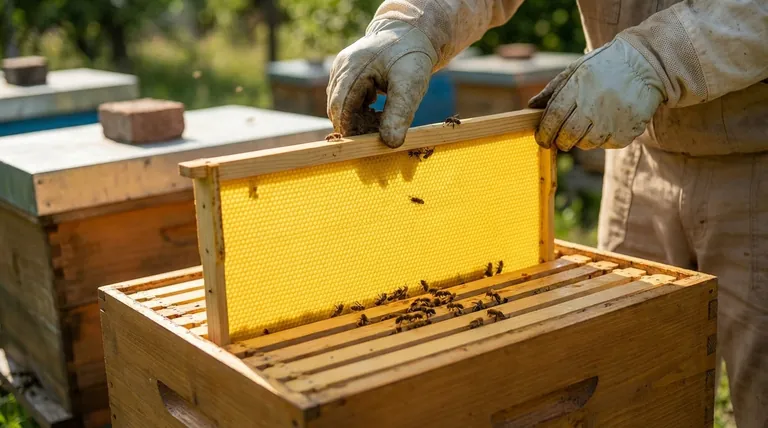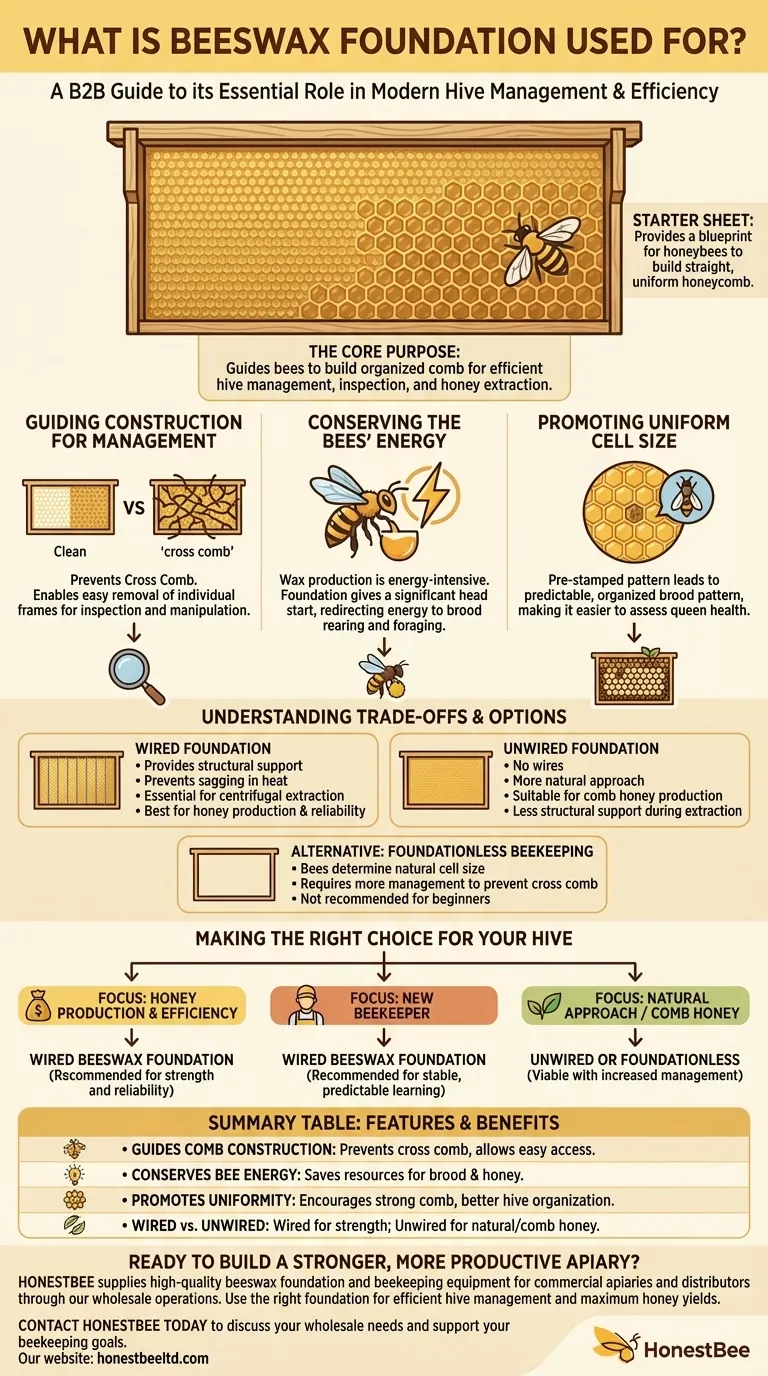In beekeeping, beeswax foundation is a starter sheet of beeswax that is placed inside a hive frame. It is imprinted with a hexagonal cell pattern that provides bees with a guide, or foundation, upon which they build their honeycomb. This simple tool is considered one of the most important inventions in modern beekeeping because it fundamentally changes how a colony organizes its hive.
The core purpose of beeswax foundation is to guide bees to build straight, uniform, and structurally sound honeycomb within a removable frame. This control is critical for efficient hive management, inspection, and honey extraction.

Why Foundation is a Cornerstone of Modern Beekeeping
Using foundation isn't about telling bees how to make wax; it's about providing a blueprint that directs where they build their comb. This guidance solves several critical problems for both the bees and the beekeeper.
Guiding Construction for Management
Without a guide, bees will often build "cross comb"—honeycomb that connects multiple frames together. This makes it impossible to remove a single frame for inspection without destroying the comb and agitating the hive.
Foundation encourages bees to build straight, orderly comb contained entirely within each frame. This allows the beekeeper to easily remove, inspect, and manipulate individual frames to check on the queen, look for diseases, or harvest honey.
Conserving the Bees' Energy
Producing beeswax is an incredibly energy-intensive process for honeybees. They must consume large quantities of honey or nectar to fuel the wax glands on their abdomens.
By providing a foundation, the beekeeper gives the bees a significant head start. The colony can then redirect its energy and resources from wax production toward other vital tasks, like raising more brood, foraging, and storing honey.
Promoting Uniform Cell Size
Beeswax foundation comes with a pre-stamped hexagonal cell pattern. This encourages the bees to build uniform cells, which leads to a more predictable and organized brood pattern.
This uniformity makes it easier for the beekeeper to assess the health and laying pattern of the queen at a glance.
Understanding the Trade-offs and Considerations
While foundation is the standard, it's important to understand the different options and the reasons a beekeeper might choose one over another.
Wired vs. Unwired Foundation
Beeswax foundation can come with or without thin metal wires embedded vertically within the wax.
Wired foundation provides significant structural support. This prevents the comb from sagging under its own weight in hot weather and, most importantly, keeps it from blowing apart during honey extraction in a centrifugal extractor.
Unwired foundation is an option for beekeepers who prefer a more natural approach or who primarily produce comb honey, which is cut directly from the frame and doesn't go through an extractor.
The Alternative: Foundationless Beekeeping
Some beekeepers choose to use frames with no foundation at all, allowing the bees to build comb entirely on their own terms.
The primary benefit is that the bees determine their own natural cell size. However, this method requires much more vigilant management to prevent cross comb and ensure the bees build straight, manageable structures. It is generally not recommended for beginners.
Making the Right Choice for Your Hive
Selecting the right foundation depends entirely on your beekeeping goals and management style.
- If your primary focus is honey production and ease of management: Wired beeswax foundation is the most practical and efficient choice for its strength and reliability.
- If you are a new beekeeper: Start with wired beeswax foundation, as it provides the most stable, predictable, and forgiving learning experience.
- If your primary focus is a more "natural" approach for comb honey: Unwired foundation or foundationless frames are viable options, provided you are prepared for the increased management demands.
Ultimately, using a foundation provides the structure that allows a bee colony to thrive and gives the beekeeper the access needed to ensure its long-term health.
Summary Table:
| Feature | Benefit |
|---|---|
| Guides Comb Construction | Prevents cross comb, allows for easy frame removal and inspection. |
| Conserves Bee Energy | Gives bees a head start, saving resources for brood rearing and honey production. |
| Promotes Uniformity | Encourages straight, strong comb for better hive organization and queen assessment. |
| Wired vs. Unwired Options | Wired offers strength for extraction; unwired suits a natural or comb honey approach. |
Ready to build a stronger, more productive apiary?
HONESTBEE supplies high-quality beeswax foundation and beekeeping equipment to commercial apiaries and distributors through our wholesale-focused operations. Using the right foundation is key to efficient hive management and maximizing honey yields.
Let us equip your operation for success. Contact HONESTBEE today to discuss your wholesale needs and discover how our reliable supplies can support your beekeeping goals.
Visual Guide

Related Products
- Beeswax Foundation Sheets Beehive Foundation for Wholesale
- Notebook Style Beeswax Foundation Mould Wax Foundation Mold
- Manual Beeswax Comb Foundation Machine Wax Foundation Mill Embossing Machine
- Colorful Silicone Beeswax Foundation Mold Mould for Beekeeping
- Electric Beeswax Foundation Machine With Operating Tray and Wax Foundation Roller
People Also Ask
- What are wax sheets made of? A Guide to Pure Beeswax Foundation for Healthy Hives
- What happens after the flattening and embossing process is complete? From Molten Wax to Solid Foundation
- How do you store beeswax foundation? Prevent Wax Moth Damage and Preserve Quality
- What are the potential issues if the wax or dipping process is not properly managed? Avoid Cracks, Ripples, and Delamination
- How do beeswax foundations save bees time and energy? Boost Hive Productivity & Honey Yield



















